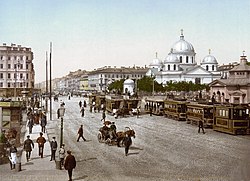Nevsky Prospect
59°55′54″N 30°21′10″E / 59.931791°N 30.352697°E


On June 27, 1941 the Council of Deputies of the Leningrad administration decided to mobilize thousands of people for the construction of fortifications
Nevsky Prospekt (Russian: Не́вский проспе́кт), or the Nevsky Avenue, is the main street in the city of St Petersburg. Planned by Peter the Great as beginning the road to Novgorod and Moscow, the avenue runs from the Admiralty to the Moscow Railway Station and, after making a turn at Vosstaniya Square, to the Alexander Nevsky Lavra. The chief sights include the Rastrelliesque Stroganov Palace, the huge neoclassical Kazan Cathedral, the Art Nouveau Bookhouse (Dom Knigi), half a dozen 18th-century churches, a monument to Catherine the Great, an enormous 18th-century shopping mall, a mid-19th-century department store, Grand Hotel Europe, the Russian National Library, and the Anichkov Bridge with its horse statues. The feverish life of the avenue was described by Gogol in his story The Nevsky Prospect. During the early Soviet years (1918-44) it was known as the Avenue of the Twenty-Fifth of October, alluding to the day of the October Revolution.
The Nevsky today functions as the main thoroughfare in Saint Petersburg. The majority of the city's shopping and nightlife, as well as the most expensive apartments, are located on or right off of the Nevsky Prospekt.

See also
External links
- English site on the Nevsky Prospekt
- Night views of the Nevsky Avenue
- Foreign churches of the Nevsky
- Palaces on the Nevsky Prospekt
- Vintage Postcards of Nevsky Prospekt
